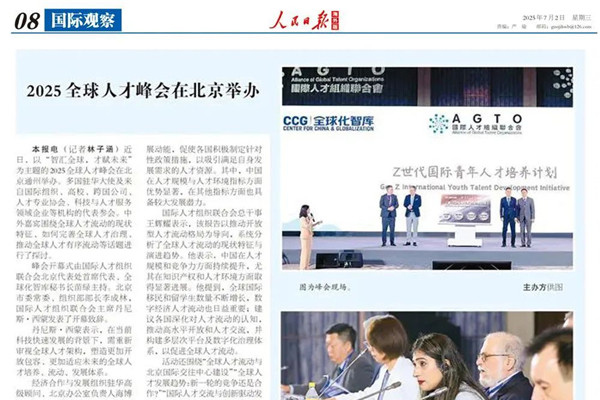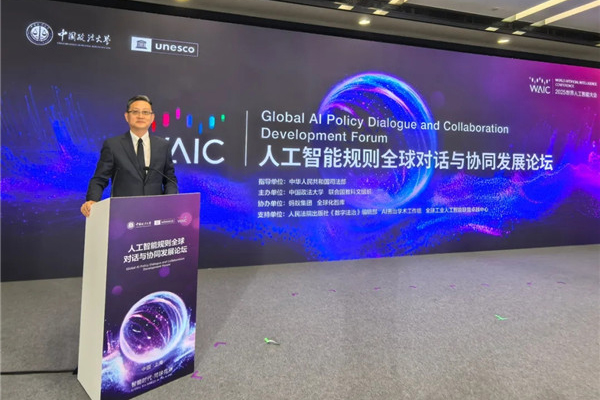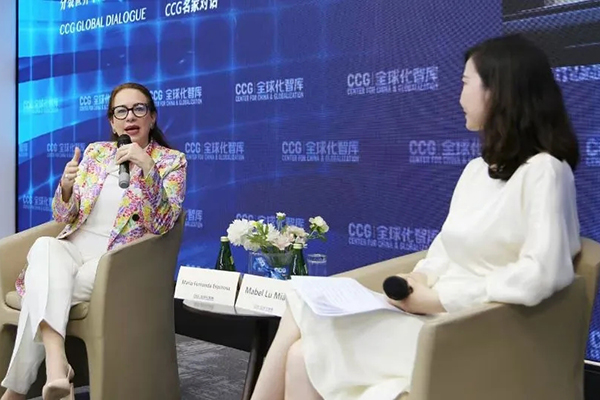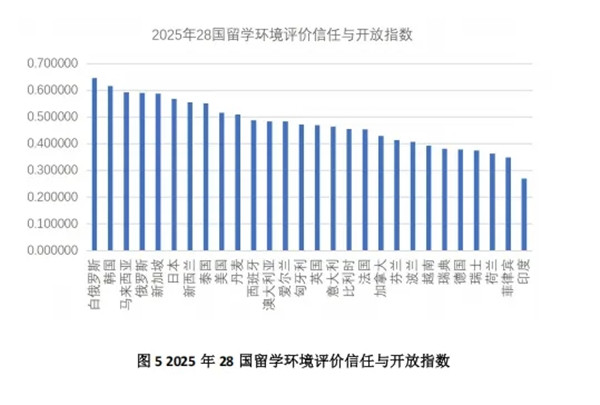【China Daily】Wang Huiyao: China ready for new globalization voyage
2018年4月8日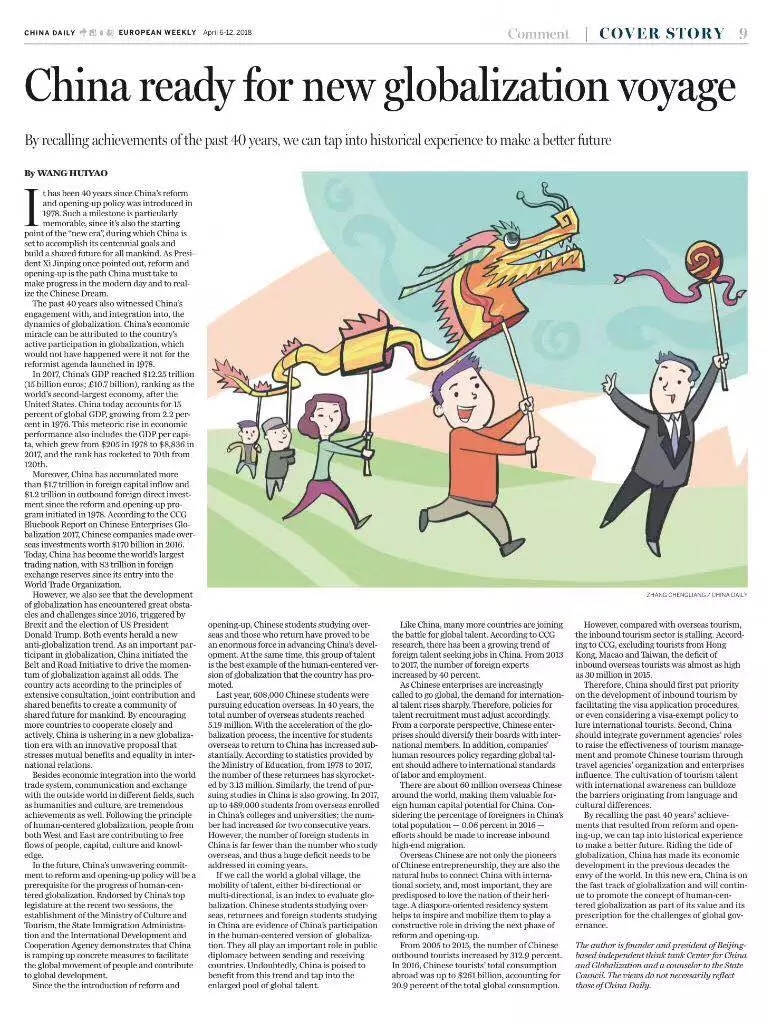
By recalling achievements of the past 40 years, we can tap into historical experience to make a better future
It has been 40 years since China’s reform and opening-up policy was introduced in 1978. Such a milestone is particularly memorable, since it’s also the starting point of the "new era", during which China is set to accomplish its centennial goals and build a shared future for all mankind. As President Xi Jinping once pointed out, reform and opening-up is the path China must take to make progress in the modern day and to realize the Chinese Dream.
The past 40 years also witnessed China’s engagement with, and integration into, the dynamics of globalization. China’s economic miracle can be attributed to the country’s active participation in globalization, which would not have happened were it not for the reformist agenda launched in 1978.
In 2017, China’s GDP reached $12.25 trillion (15 billion euros; £10.7 billion), ranking as the world’s second-largest economy, after the United States. China today accounts for 15 percent of global GDP, growing from 2.2 percent in 1976. This meteoric rise in economic performance also includes the GDP per capita, which grew from $205 in 1978 to $8,836 in 2017, and the rank has rocketed to 70th from 120th.
Moreover, China has accumulated more than $1.7 trillion in foreign capital inflow and $1.2 trillion in outbound foreign direct investment since the reform and opening-up program initiated in 1978. According to the CCG Bluebook Report on Chinese Enterprises Globalization 2017, Chinese companies made overseas investments worth $170 billion in 2016. Today, China has become the world’s largest trading nation, with $3 trillion in foreign exchange reserves since its entry into the World Trade Organization.
However, we also see that the development of globalization has encountered great obstacles and challenges since 2016, triggered by Brexit and the election of US President Donald Trump. Both events herald a new anti-globalization trend. As an important participant in globalization, China initiated the Belt and Road Initiative to drive the momentum of globalization against all odds. The country acts according to the principles of extensive consultation, joint contribution and shared benefits to create a community of shared future for mankind. By encouraging more countries to cooperate closely and actively, China is ushering in a new globalization era with an innovative proposal that stresses mutual benefits and equality in international relations.
Besides economic integration into the world trade system, communication and exchange with the outside world in different fields, such as humanities and culture, are tremendous achievements as well. Following the principle of human-centered globalization, people from both West and East are contributing to free flows of people, capital, culture and knowledge.
In the future, China’s unwavering commitment to reform and opening-up policy will be a prerequisite for the progress of human-centered globalization. Endorsed by China’s top legislature at the recent two sessions, the establishment of the Ministry of Culture and Tourism, the State Immigration Administration and the International Development and Cooperation Agency demonstrates that China is ramping up concrete measures to facilitate the global movement of people and contribute to global development.
Since the the introduction of reform and opening-up, Chinese students studying overseas and those who return have proved to be an enormous force in advancing China’s development. At the same time, this group of talent is the best example of the human-centered version of globalization that the country has promoted.
Last year, 608,000 Chinese students were pursuing education overseas. In 40 years, the total number of overseas students reached 5.19 million. With the acceleration of the globalization process, the incentive for students overseas to return to China has increased substantially. According to statistics provided by the Ministry of Education, from 1978 to 2017, the number of these returnees has skyrocketed by 3.13 million. Similarly, the trend of pursuing studies in China is also growing. In 2017, up to 489,000 students from overseas enrolled in China’s colleges and universities; the number had increased for two consecutive years. However, the number of foreign students in China is far fewer than the number who study overseas, and thus a huge deficit needs to be addressed in coming years.
If we call the world a global village, the mobility of talent, either bi-directional or multi-directional, is an index to evaluate globalization. Chinese students studying overseas, returnees and foreign students studying in China are evidence of China’s participation in the human-centered version of globalization. They all play an important role in public diplomacy between sending and receiving countries. Undoubtedly, China is poised to benefit from this trend and tap into the enlarged pool of global talent.
Like China, many more countries are joining the battle for global talent. According to CCG research, there has been a growing trend of foreign talent seeking jobs in China. From 2013 to 2017, the number of foreign experts increased by 40 percent.
As Chinese enterprises are increasingly called to go global, the demand for international talent rises sharply. Therefore, policies for talent recruitment must adjust accordingly. From a corporate perspective, Chinese enterprises should diversify their boards with international members. In addition, companies’ human resources policy regarding global talent should adhere to international standards of labor and employment.
There are about 60 million overseas Chinese around the world, making them valuable foreign human capital potential for China. Considering the percentage of foreigners in China’s total population – 0.06 percent in 2016-efforts should be made to increase inbound high-end migration.
Overseas Chinese are not only the pioneers of Chinese entrepreneurship, they are also the natural hubs to connect China with international society, and, most important, they are predisposed to love the nation of their heritage. A diaspora-oriented residency system helps to inspire and mobilize them to play a constructive role in driving the next phase of reform and opening-up.
From 2005 to 2015, the number of Chinese outbound tourists increased by 312.9 percent. In 2016, Chinese tourists’ total consumption abroad was up to $261 billion, accounting for 20.9 percent of the total global consumption.
However, compared with overseas tourism, the inbound tourism sector is stalling. According to CCG, excluding tourists from Hong Kong, Macao and Taiwan, the deficit of inbound overseas tourists was almost as high as 30 million in 2015.
Therefore, China should first put priority on the development of inbound tourism by facilitating the visa application procedures, or even considering a visa-exempt policy to lure international tourists. Second, China should integrate government agencies’ roles to raise the effectiveness of tourism management and promote Chinese tourism through travel agencies’ organization and enterprises influence. The cultivation of tourism talent with international awareness can bulldoze the barriers originating from language and cultural differences.
By recalling the past 40 years’ achievements that resulted from reform and opening-up, we can tap into historical experience to make a better future. Riding the tide of globalization, China has made its economic development in the previous decades the envy of the world. In this new era, China is on the fast track of globalization and will continue to promote the concept of human-centered globalization as part of its value and its prescription for the challenges of global governance.

Dr. Wang Huiyao, founder and president of the Center for China and Globalization(CCG), an independent think tank based in Beijing.
From China Daily,2018-4-6
